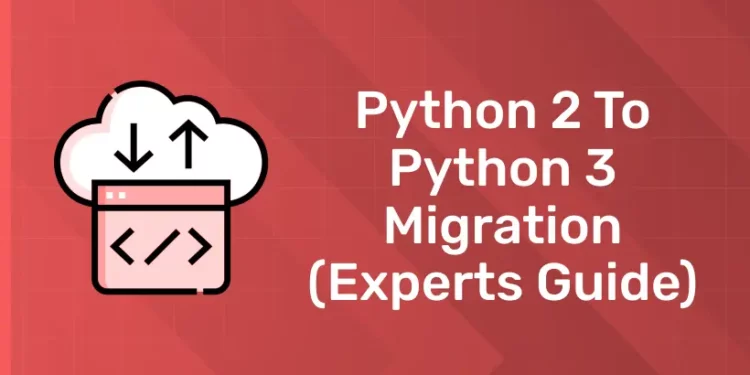Table of Contents
Python is so widely used and so user-friendly, a lot of newbie programmers study it as their first language. Currently, Python 2 and Python 3 are the two versions of this programming language in use. Even if there are some parallels between Python 2 to Python 3 Migration, there are also some significant variances.
When choosing which version of Python to use, developers and novices alike should carefully analyse the trade-offs between versions 2 and 3, taking into account things like compatibility with existing code, the availability of third-party libraries, and the newest features available in the language. This article compares and contrasts Python 2 and Python 3, pointing out their advantages and disadvantages as well as how to switch from Python 2 to Python 3.
Unlock Your Coding Potential with Our Python Programming Course – Enroll Today
Introduction
One of the computer languages that has completely changed the face of technology is Python. General-purpose programming languages are used in many different fields, such as software engineering, artificial intelligence, natural language processing, data analysis, and more.
The public domain was opened to Python 2 and Python 3, two of the most noteworthy versions of the language. Despite being just two different versions of the same computer language, it might be interesting to compare and contrast Python 2 and Python 3. Unexpectedly, there are significant differences between the two. There has been a lot of controversy in the past about which of the two versions is better to use.
What is Python 2?
Python 2.0 was made available to the computer community in 2000. The BeOpen Python Labs team released Python 2 with the intention of making programming more approachable and available to a wider audience.
The technical elements of the Python Enhancement Proposal (PEP) were successfully implemented in Python 2. However, Python 2’s popularity in the tech sector declined significantly once Python 3 was released, and the last version of Python 2 was released in 2020; Python 2.7 being the last one.
What is Python 3?
When Python 3 was first published in 2008, it was more than just a polished version of Python 2 after debugging. Eliminating redundancy the practice of writing the same code again or repetitively was the main driving force for Python’s introduction. Python 3 aims to address the problems that inexperienced programmers go into when learning the language with its backward incompatibility.
Differences Between Python 2 and Python 3
1: Which of the following data types is immutable in Python?
We are well-versed in the background of Python’s two main versions, let’s examine their main distinctions and determine which version emerges victorious in the contest: Python 3 and Python 2.
There were multiple versions of Python available for a variety of reasons. First of all, converting all industrial code from Python 2 to Python 3 would have been a laborious and time-consuming task because so much Python 2 code had previously been produced.
Comparison Python 2 and Python 3
| Comparison Parameter | Python 2 | Python 3 |
| Released Year | In the year 2000, Python 2 was released. | In the year 2008, Python 3 was released. |
| Usage of Keyword “Print” | Print is seen as a statement in Python 2, not a function. | Print is regarded as a function rather than a statement in Python 3 |
| String values storages | Strings are automatically stored as ASCII in Python 2. | Strings are automatically stored as UNICODE in Python 3. |
| Integers Division | In Python 2, we obtain an integral value on the division of two numbers. For example, in Python 2, 7/2 produces 3. | In Python 3, we obtain a floating-point result when we divide two integers. For example, in Python 3, 7/2 returns 3.5. |
| Exceptions | Python 2 uses notations to enclose exceptions. | Python 3 puts parenthesis around exceptions. |
| Variable leakage | In Python 2, using global variables inside a for-loop causes their values to change. | In Python 3, variables’ values are constant. |
| Iteration | The xrange() function has been defined for iterations in Python 2. | To execute iterations, Python 3 added a new method called Range(). |
| Ease of Syntax | The syntax of Python 2 is more intricate than that of Python 3. | The syntax of Python 3 is simpler than that of Python 2. |
| Libraries | Many Python 2 libraries are not forward compatible. | Many libraries are written in Python 3 and are intended only to be used with Python 3. |
| Use in the modern era | Since 2020, Python 2 has not been used. | Python 3 is still in use today and has more popularity than Python 2. |
| Compatibility | It takes a lot of work to port Python 2 routines to Python 3. | Python 3 and Python 2 are not backwardly compatible. |
| Application of Python | The primary tool utilised to become a DevOps Engineer was Python 2. After 2020, it is no longer in use. | Numerous professions, including software engineering and data science, employ Python 3. |
Unlock Your Coding Potential with Our Python Programming Course – Enroll Today
Manual Method for Python 2 to 3 Migration
- The goal of the manual code rewrite approach is to update the programme to comply to Python 3.
- You say farewell to the previous iteration and its legacy code, but the earlier code continues to serve as a source of unit testing test cases and references.
- Moving the outdated unit test cases to the Python 3 environment is the first step towards building the new code. New code is written in response to the results of these tests, whether they pass or fail.
- It is necessary to redo the codes that don’t pass the unit test. The ones that survive can be kept safe.
- It is imperative to address any latent flaws discovered in the outdated code, as they may not present amicably in the Python 3 environment as they did in the previous iteration.
- It is occasionally necessary to rewrite some new unit tests for Python 3. This is because the mock libraries that are integrated into the more recent version of Python make the unit tests easier to write.
- The tests need to be in line with the updated software architecture as well. But, you can leave simpler unit tests alone if they don’t depend on special features of Python 3.
Automated Way for Python 2 to 3 Migration
It is nearly hard to write every line of code again and test iteratively when you have a large code base. That would take a tremendous amount of time, money, and effort. It is advised to use automated migration for such projects.
Additionally, tools that enable automation make this feasible. Similarly, we have a programme for automated migration to Python 3 that goes by the simple moniker 2to3.
There are 6 steps involved in the automated migration from Python 2 to 3. Let’s take a closer look at each of them:
1. Establishing unit test cases:
Since it is essential to writing functional code, this is one of the most important steps in the migration process. But occasionally, this can become difficult. Sometimes unit tests are not written for the legacy code, or they do not address specific migration problems such as data type conversions. Worse even, they might have been created in a syntax that has completely altered since then. Tools like 2to3 and Six come in pretty handy in these kinds of situations.
2. Fixing syntactic changes-related problems:
The actual migration begins at this point. This stage addresses the problems that result from changes in syntax. The Pylint tool assists with this procedure by pointing out Python 3 version issues.
3. Executing the test cases within the contexts of Python 2 and Python 3:
The legacy code is subjected to unit testing. Typically, every unit test fails during the first iteration. Having a method to continuously run unit tests until you get it correct is the key.
4. Making the migration with the 2to3 tool:
The available code will be migrated by the 2to3 tool based on the unit test failure report. While the migrated code should function as intended, there may be times when minor grammatical changes and revisions to the unit test cases are necessary. Rerunning the unit tests and performing many migrations are necessary if there are errors until the code achieves its intended goal.
5. Retest after fixing the issues:
The effort is not even half finished until the code has been completely converted to Python 3! The Python 3 environment will now be used to test the code. It could be necessary to modify the Python 2 code and carry out the migration again. Alternatively, you would have advanced past that point and Python 3 code modifications would be sufficient. Thus, these little changes will need to be made repeatedly until the code is fully functional and free of errors and has undergone a full migration.
6. Post-migration optimisation:
Occasionally, certain undesired parts are introduced into the code during an automatic conversion. Anything from an additional float function to a list function could be among them. It is necessary to tidy up these components. And additional testing is required to be extra cautious.
Unlock Your Coding Potential with Our Python Programming Course – Enroll Today
🚀 Start Coding Today! Enroll Now with Easy EMI Options. 💳✨
Gain expertise in Django and open doors to lucrative opportunities in web development.
Start Learning With EMI Payment OptionsStrategies for Migration
Although the transition from Python 2 to Python 3 may appear difficult, it may be a simple and fruitful process if planned and carried out carefully. By using these techniques, you may take advantage of Python 3’s most recent features and enhancements while ensuring a successful transfer.
Only supporting Python 3
- When you only need to support one version of Python at a time, it is the easiest scenario to handle. In certain situations, you can simply abandon Python 2 and switch your work to Python 3.
- Using this method, you will first automatically convert the majority of the modifications using the 2to3 tool, and then you will manually correct any remaining issues in the Python 3 code.
- Since the 2to3 conversions might not always be the best option for your situation, you should definitely go through and clean up all of the converted code.
Converting Python 2 to Python 3
Since Python 2 and Python 3 differ significantly from one another, porting code from one language version to another can be difficult. Testing imported code is essential to make sure it functions as intended. You can use the resources listed below to convert Python 2 to 3.
- Python 2to Python 3 is a Python script that uses a set of transformations known as fixers to automate the conversion of Python 2 code to Python 3 code. While portion of the converting process is automated by this command-line script, further manual adjustments could be necessary.
- With the help of this compatibility module, you may write code that works with Python 2 and 3. It assists you in balancing out the variations between the two Python versions. The package can be imported into a Python script and installed using pip.
- With the help of the library Python-Future, code written for Python 2 and Python 3 can be written. With the help of this library, users can support both versions with little overhead by using a single codebase. Cheat sheets for writing Python 2 and 3 compatible code are also available on Python-Future.
Python 2 and Python 3 have different Branches.
- Having a branch in your source tree containing the code for Python 2 and another branch containing the code for Python 3. It is the easiest scenario if you must continue to support Python 2.
- Subsequently, all modifications must be made on both branches, which adds a little extra work but is manageable if code changes seldom.
- Having two distributions and having to make sure that Python 3 users receive the Python 3 version of your package. And Python 2 users receive the Python 2 version is one issue with this technique. It also makes your distribution more complex.
Similarities between Python 3 and Python 2
- Python 2 and Python 3 have nearly the same core syntax and structure.
- The variables and data types in Python 2 and Python 3 are identical.
- Both versions continue to utilise indentation to denote code blocks.
- A sizable library of modules covering a range of topics, including file input and output, regular expressions, and networking, is included in both versions.
- You can enter code in the interactive mode of both versions to see the results right away.
- Programming that is object-oriented is supported by both versions.
- Variables do not need to be defined with a specific data type in either version thanks to dynamic typing.
- A sizable and vibrant group of developers actively participates in both versions development and offers assistance.
Python 2 and Python 3 without Conversion
- Although you must use a few strategies to avoid the incompatibilities between Python 2 and Python 3. it is frequently entirely possible to adapt the code so that it runs under both Python 2 and Python 3 without the need for any conversions.
- Because of their great forward compatibility, Python 2.6 and 2.7 are far easier to support than Python 2.5 and Python 3, which makes 2.6 and 3 considerably more manageable.
- You have to use extra methods to support versions 2.5 or even older.
- The u” literal for strings is also back in Python 3.3, which helps with one of the main challenges of supporting Python 3.
- In certain situations, you may not be able to use Distribute or may choose not to. It could be necessary to release your code in a format that cannot be distributed using Distribute because it cannot be installed using Distutils.
- When that happens, you are unable to utilise Distribute’s Python 2 to Python 3 support, which makes using Python 2 to Python 3 more difficult and making the decision to forgo using Python 2 to Python 3 more alluring.
Using Python 3 to Python 2
- Because of the Python 2 to Python 3 tool’s flexibility, you can specify what modifications need to be made by creating “fixers.”
- This place allows for almost any kind of Python code conversion, and Joe Amenta’s Python 3 to Python 2 fixers perform conversions between Python 3 and Python 2.
- This allows you to write your Python 3 code and, before it is released, convert it to Python 2.
- Nevertheless, Python 3 to Python 2 does not have Distribute support, and Python 2.5 and below do not provide with the necessary library Python 2 to Python 3 module.
- As a result, Python 3 to Python 2 is still simply an intriguing experiment at this time, however this could change in the future.
| Related Article | |
| Best Python Certification for All Levels in 2024 | Python GUI Frameworks You Must Know in 2024 |
| Python Naming Convention | Hadoop vs Python: Which is Better to Learn in 2024 |
🚀 Start Coding Today! Enroll Now with Easy EMI Options. 💳✨
Gain expertise in Django and open doors to lucrative opportunities in web development.
Start Learning With EMI Payment OptionsFrequently Asked Questions
Is it easy to learn Python 3 after Python 2?
Because of its emphasis on code readability, Python 3 is simpler to learn and use than its predecessors.–
Is Python 2 compatible with Python 3?
The fact that Python 3 is incompatible with Python 2 is another benefit of using it. Although it may seem like a drawback, there are certain advantages. Writing code particularly for Python 3 is simpler because Python 3 is incompatible with Python 2.












